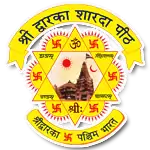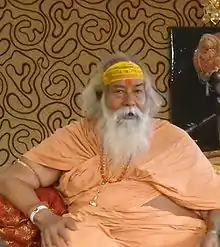Dwarka Sharada Peetham
Pascimāmnāya Śrī Śāradā Pītham or Dwarka Sharada Math,[1][note 1] is one amongst the four cardinal peethams established by the 8th century philosopher-saint Adi Shankara to preserve and propagate Sanatana Dharma and Advaita Vedanta, the doctrine of non-dualism. Located in the city of Dwaraka, Gujarat, India it is the pascimāmnāya matha, or Western Āmnāya Pītham[3] amongst the four Chaturāmnāya Pīthams, with the others being the Sringeri Śārada Pīṭhaṃ (Karnataka) in the South, Purī Govardhanmaṭha Pīṭhaṃ (Odisha) in the East and Badari Jyotirmaṭha Pīṭhaṃ (Uttarakhand) in the North. It is also known as the Kālikā Matha.[4] Their Vedantic mantra or Mahavakya is Tattvamasi (That thou art) and as per the tradition initiated by Adi Shankara it holds authority over Sama Veda.
 Dwarka Sharda Peeth logo | |
| Motto | Tattvamasi (That thou art) |
|---|---|
| Formation | 461 AD |
| Founder | Adi Shankara |
| Type | Religious |
| Location |
|
First Shankaracharya | Hastamalakacharya |
Present Shankaracharya | Swaroopanand Saraswati |
| Website | http://www.shrisharadapeetham.org/ |

History
- Shri Trivikrama Tirtha was the head of the monastery until 1921 when he was succeeded by Sri Bharati Krishna Tirtha.
- Shri Bharati was invited to lead the Puri matha in 1925 after the position had become vacant.
- Shri Bharati was succeeded by Shri Swarupananda and Shri Yogeswarananda.
1945
In 1945, Shri Abhinava Saccidananda Tirtha was nominated to the position. Before assuming his position at Dvaraka, Abhinava was the head of the Mulabagal matha in Karnataka, which was the 17th century branch of the Dvaraka matha. As a result, the cumulative lineage of Mulabagal matha was merged with Dvaraka when Abhinava took office there. Years later Shri Saccidananda helped to mediate the Shankarcharya successions at Puri and Jyotir Math.[5] Since Abhinava died in 1982, this peeth has been led by Swami Swarūpānanda Saraswatī[5][6] who is one of the claimants to the position of Shankaracharya of the northern matha called Jyotir Pitha or Jyotir Math.[7]
See also
Notes
- Dvaraka Peeth, located in the west, and Sringeri Sharada Peetham, located in the south, are both called "Sharada Peeth".[2]
References
- nn 1964, p. 12.
- Singh & Mishra 2010, p. 322.
- Pasricha, Prem C. (1977) The Whole Thing the Real Thing, Delhi Photo Company, p. 59-63
- Nirmala Ramachandran (2000). Hindu Heritage, Volume 1. Stamford Lake Publication. p. 101. ISBN 9789558156438.
They are Jyotir-math at Badarinath, Kalika peetham at Dwarka, Govardhana peetham at Jagganath Puri, Sarada peetham at Sringeri and the Kamakoti peetham at Kanchi. Adi Shankara was the greatest exponent of the Advaita philosophy.
- Unknown author (5 May 1999) archived here. Accessed: 2012-08-30. or here%5D The Monastic Tradition Advaita Vedanta web page, retrieved 28 August 2012
- Author unknown (2008) Swami Swarupananda Saraswati bio Web site of Swami Swarupananda Saraswati, retrieved 4 August 2012
- Unknown author (2005) Indology The Jyotirmaṭha Śaṅkarācārya Lineage in the 20th Century, retrieved 4 August 2012
Sources
- nn (1964), Śāradā pīṭha pradīpa, Volumes 4-6, Indological Research Institute, Dwārka
- Singh, N.K.; Mishra, A.P. (2010), Global Encyclopaedia of Indian Philosophy, Volume 1, Global Vision Publishing House, ISBN 9788182202948